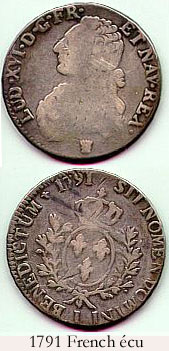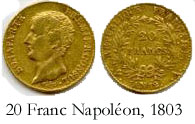APAC100: Difference between revisions
From Marist Studies
Jump to navigationJump to search
mNo edit summary |
mNo edit summary |
||
| Line 13: | Line 13: | ||
[[Image:1803 Napoleon.jpg|right|A gold Napoléon coin, dating from 1803, worth 20 francs]] | [[Image:1803 Napoleon.jpg|right|A gold Napoléon coin, dating from 1803, worth 20 francs]] | ||
:In 1839 Bataillon wrote that the Methodist missionaries (probably in Tonga) were paid a thousand francs (for man and wife) a year by their home organization. There was a special allocation for each child.<ref> [[Girard0038|LRO, doc. 38]] [10].</ref> In 1848 the upkeep of a catholic missionary too was set at 1.000 francs a year.<ref> Bernard Bourtot, ''Colin, les missions et leur financement en 1848'', in Document SM Nr. 71, April 2007. Centre de Documentation Mariste, 6, rue Jean Ferrandi, 75006 Paris, p. 23.</ref> | :In 1839 Bataillon wrote that the Methodist missionaries (probably in Tonga) were paid a thousand francs (for man and wife) a year by their home organization. There was a special allocation for each child.<ref> [[Girard0038|LRO, doc. 38]] [10].</ref> In 1848 the upkeep of a catholic missionary too was set at 1.000 francs a year.<ref> Bernard Bourtot, ''Colin, les missions et leur financement en 1848'', in Document SM Nr. 71, April 2007. Centre de Documentation Mariste, 6, rue Jean Ferrandi, 75006 Paris, p. 23.</ref> | ||
Revision as of 12:40, 12 February 2008
Excursus B : money matters

- The most commonly mentioned currency in the correspondence from Oceania is the French franc. In Australia and New Zealand the pound sterling was the common currency and one pound was equivalent to 25 French francs, which puts the franc at just under nine pence.[1] The missionaries nonetheless often kept thinking in terms of francs. In 1851 Rocher wrote to Colin from Sydney that due to the gold rush he had to pay £ 26 for a ton of flour, and 30 centimes for a loaf of bread, threepence would have meant nothing to Colin.[2] Sometimes there is mention of the écu (scudo in Italian), which meant an amount of three francs.[3] A Napoléon was a coin worth 20 francs.[4] During the voyages via South America the piastre, equivalent to 5.5 francs, was the common currency.
- Gold was considered the basic standard for all currencies, and often money was sent in the form of gold coins. The 8.700 francs sent from France in May 1837 came to 100.72 ounces, which means that one paid just over 86.3 francs for one ounce of gold.[5] In France the Spanish gold coins that were used in South America could be had for 84 or 85 francs, which puts them at about one ounce of gold.[6]
- Mass stipends in France were one franc and from a remark of Fr. Chanut to Marcellin Champagnat it would appear that for a priest of the time his daily Mass stipends meant a modest but adequate living allowance.[7]

- In 1839 Bataillon wrote that the Methodist missionaries (probably in Tonga) were paid a thousand francs (for man and wife) a year by their home organization. There was a special allocation for each child.[8] In 1848 the upkeep of a catholic missionary too was set at 1.000 francs a year.[9]
Notes
- ↑ Cf. Dillon writing to Colin, quoted in Wiltgen, op. cit. p. 217. in 1841 Fr. Garin writes to Colin of a gift of 30 pounds and explains: 600 francs; probably an unthinking remark, LRO, doc. 111 [11].
- ↑ LRO, doc. 1062 [12].
- ↑ Above, p. 69. LC I, doc. 230.
- ↑ Cf. LRO, doc. 7 [14].
- ↑ Pompallier to Meynis, 17.03.1839, OPM, H30, 000867
- ↑ LRO, doc. 7 [14].
- ↑ Cf. CS, doc. 53 [5].
- ↑ LRO, doc. 38 [10].
- ↑ Bernard Bourtot, Colin, les missions et leur financement en 1848, in Document SM Nr. 71, April 2007. Centre de Documentation Mariste, 6, rue Jean Ferrandi, 75006 Paris, p. 23.
| Previous Section | A Piety Able to Cope | Next Section |